
Donate to Innerviews
Since 1994, Innerviews has provided uncompromising, in-depth interviews with musicians across every genre imaginable. And it does that with no trackers, cookies, clickbait, or advertising.
Your donations are welcome to help continue its mission of highlighting incredible music and artists, without any commercial considerations.
Your contributions will be instantly transformed into stories and videos, and cover hosting and web management costs. Importantly, your dollars will help ensure Innerviews remains absolutely free to all visitors, independent of their ability to financially support it.
Please consider making a donation today by using the PayPal QR code below.

Steve Hackett
Reimagining History
by Anil Prasad
Copyright © 2012 Anil Prasad.
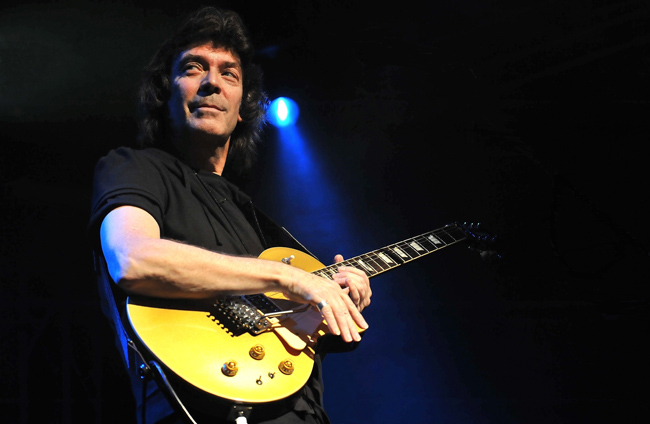
For prog-rock devotees, Steve Hackett’s ‘70s work with Genesis is the guitar equivalent of the Sermon on the Mount. Since departing from the band in 1977, he has significantly expanded his horizons across a prolific solo career spanning 34 diverse releases. His albums have drawn inspiration from a wide array of genres and influences, including the worlds of classical, orchestral, blues, folk, Indian, Turkish, and flamenco. But the guitarist, who straddles electric and acoustic realms, has retained an affection for his prog roots, as evidenced by his two new albums.
Squackett’s A Life Within a Day, a collaboration with Yes bassist Chris Squire and producer/keyboardist Roger King, offers up a set of melodic, accessible songs, full of lush harmony vocals and addictive hooks. It’s sophisticated, prog-infused pop inspired by the late-‘60s “anything goes” psychedelic era.
While Squackett favors brevity and tight structures, Hackett’s new Genesis Revisited II double-album returns to the epic approach of his former band. It’s the second chapter of reworkings that began with the first Genesis Revisited album from 1996. Hackett calls the new disc a “re-voiced, rewired and restrung” take on some of the band’s most revered ‘70s pieces, including “Supper’s Ready,” “Dancing with the Moonlit Knight” and “The Musical Box.” He also reexamines signature Genesis-related solo tracks, such as “Shadow of the Hierophant” and “Please Don’t Touch.” An all-star prog lineup joins Hackett, including Porcupine Tree’s Steven Wilson and Marillion’s Steve Rothery on guitar; Dave Kerzner on keyboards; and Asia’s John Wetton, Opeth’s Mikael Åkerfeldt, and intriguingly, Phil Collins’ son Simon Collins on vocals.
You’ve been prolific in recent years. Describe the underpinnings of the creative streak you’re on.
I’ve redoubled my efforts since my wife Jo and I have been together, in the full-time sense of the word. We got married last year. It’s very much a partnership in which we’re both very driven. I think there’s a sense of wanting to make up for lost time with each other and to work full time within this creative partnership, and transmit the results across as many forms as we can. Jo has been involved in making movies and writing books. I’ve been involved in many aspects of music, and a lot of other things as well. This involves business too. Both of us are in the driver’s seat. We’re at the vanguard of it. We don’t employ managers anymore. We have a team of people who all have specific functions. We want to be the first to know what’s happening, rather than being the last to know. That makes a very big difference.
Also, if I want to do a gig in Malaysia because it’s offered, I can say yes. What tends to happen when you’re managed by somebody is you get asked to play Live Aid and the guy thinks it’s not going to be a good idea because you’re not going to get paid. I think businessmen have vested interests that do not necessarily look beyond the immediate yield. In the past few years, we’ve been sowing seeds along the way. We’ve been involved in several albums, including Squackett and Genesis Revisited II, which includes all of the best Genesis stuff I did.
I think there’s a sense that because Jo and I weren’t able to be together full-time until recently, we’re now going at things like a couple of kids. Jo and I have known each other for a very long time. I was officially married to someone else for a period of time and that previous relationship was bound up with a lot of other things, including business interests and what have you. All I can say is with Jo, there are no hidden agendas. It’s about pooling our resources. Jo loves to travel. The idea of me being on the road is not too much trouble for her, because she comes to all of the gigs, which is great. And whenever we tour, we try to meet the audiences wherever we can and take them into our confidence. We share time with them. We don’t draw the distinction anymore between what’s going on onstage and what’s happening out front. Most of the time, that works out great, although time can get a little hairy sometimes. I see audiences as friends. Jo manages to make it all happen and I can’t really thank her enough for all sorts of reasons.
Whenever we travel, Jo makes it an event. It doesn’t matter if the place is or isn’t a capital city in an exotic location. She’s interested in the history of places and looks beyond surface appearances. For instance, her mother lives in Norfolk, East Anglia. In that area, just around the corner, there’s a little village that used to be a major Roman town. That’s typical of the sorts of things she knows that I don’t. She’s always informing in that way, so it’s a very interesting partnership. She’s fascinated by music. Her father is both a musician and a teacher—as was her grandfather. So, I think music has always been around for her. An appreciation of music has always been very important for her. She also gets to write lyrics with me. Very often, she’ll come up with the top line for something. She’ll also tell me if she thinks a variation is needed where I might go for a repeat. Musicians are famous for repeating themselves. I find it very interesting that she has a musical facility, without necessarily knowing all of the chords. So, we share quite a bit these days.
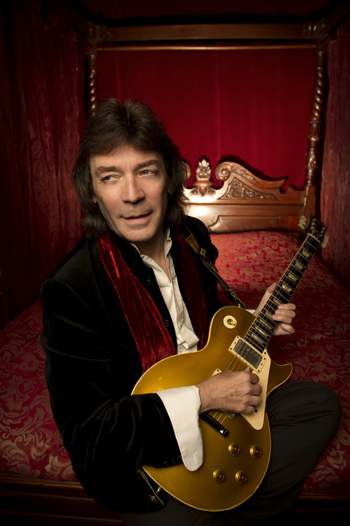
The titles of your last two solo albums, Out of the Tunnel’s Mouth and Beyond the Shrouded Horizon, imply a journey of emancipation in progress.
I think you’re right. Both are journeying titles that are full of longing. Beyond the Shrouded Horizon is a clarion call to adventure of whatever kind that may be. Of course, we do travel literally, figuratively and metaphorically. It starts in the imagination. Out of the Tunnel’s Mouth had to do with the need for autonomy and emancipation, as well as the feeling that you just made it by the skin of your teeth, as indeed I did. So, time and time again, I come back to the issue of autonomy. It’s the reason I left Genesis. “Autonomy” is a small word, but the world turns on those few syllables.
Will there be a third, concluding chapter to this series of solo albums?
Probably. I’m dying to get involved in another one. Right now, I’m focusing on the Genesis stuff, revising that music for all sorts of reasons. It’s an answer to a call. People are interested in what I played in 1903. As a bigger answer to the call, I’m presenting everything in a new context and will be touring it. It’s a recreation of a one-time cathedral with matchsticks. Beyond that, I’m thinking about the modern high-rises I might build. I find myself constantly thinking about acoustic music and its relevance to electric music, and what the real difference is between plugging something in and recording something with a microphone. It’s all sound, isn’t it? At the end of the day, I tend to be influenced by orchestral textures. Then again, I think nylon guitar is a very orchestral instrument. It’s a very clever percussion instrument. You can do all sorts of things with it, depending on how you treat it. You can create a continuous note with it. The fact that it’s not necessarily plugged in is purely incidental.
What’s unique about the creative partnership you share with Chris Squire in Squackett?
I knew Chris’ work way before he knew me. Yes was a very interesting band in all its incarnations. There was something similar between the approach of Yes and Genesis. They started to take on symphonic ideas and they each had a syncopated feel to their music. When it worked at its peak, both bands were very similar—almost interchangeable, rhythmically. Phil Collins was always a huge fan of Yes. Personally, I was always very drawn to the idea of harmony vocals. I always wanted Genesis to do more of that. I’ve employed it extensively in my own stuff. Chris, of course, is also a huge fan of harmony vocals, right from the time he was a choirboy as a kid to the present day. When we talk about our favorite bands, Chris and I often talk about bands that use harmony vocals—never mind what the lead singer is like. Harmony vocals give everyone a voice in the band. I’m thinking of The Beatles, The Who, Crosby, Stills and Nash, The Mamas and the Papas, and The Byrds. I feel the harmony vocals distinguished these bands from the amazing blues-based workouts of Cream and Eric Clapton.
Chris and I met very briefly in the mid-‘80s when I was involved in GTR. We played a show in Los Angeles that Chris attended. We had an interesting conversation afterwards. He enjoyed the two-guitar lineup. I complimented him on various incarnations of Yes. He said he enjoyed A Trick of the Tail a lot and that he felt it was Genesis’ best album. Then we lost touch for a while. In 2007, Chris wanted to make a Christmas album and asked me if I’d play guitar on it. I said yes. I would jump at the chance of working with Chris even if he was making a country or punk album. We worked together and decided we liked the chemistry.
One thing I noticed with Chris straightaway is unlike many professional musicians I’ve worked with, Chris only really works on something if he enjoys it. I had a couple of tunes on hand and asked if he would play bass on them. I thought “He’s really enjoying it. He isn’t making this up. He’s not just going through the motions.” I thought that was fab. He wanted to play straight bass lines. He really doesn’t actually play the rhythm. Rather, he plays a counter-rhythm and counter-melody which is very creative. He has very interesting ideas.
Elaborate on the chemistry you share with Squire.
What’s complementary is that we both have a sense of humor. I may sound very serious when you and I are talking, because it’s difficult to crack jokes when you’re trying to be revealing, but Chris and I spent a lot of time together. Our families spent time together. Our ladies spent time together. We went to gigs, shows, restaurants—we just went out into the world often. A lot of that was brought to bear in the music. We saw jazz and rock gigs. We went to see practically every act in town. I was amazed Chris liked to relax during the evening by going out to see Joe Bonamassa. He said “Joe does a Yes tune.” So we went and we’re standing there watching Joe do “Starship Trooper.” We met him afterwards and Joe said “We used to do a version of ‘Los Endos’ from A Trick of the Tail.” I thought that was interesting. Joe is a fabulous player and his interest in our music was a compliment for both of us. There’s some kind of crossover happening. There’s Joe, firmly rooted in the blues, and performing them marvelously. Beyond that, there’s some kind of addiction to form and to English music of a certain era—this progressive tag, both Chris and I have.
I’ve been talking to people recently who say “There is no such thing as progressive music.” What does it mean? Music that has changes? Music that integrates a wider glossary of terms? Music that takes onboard other genres? Music that’s not a three-minute pop song? I don’t know, but it seems to imply some kind of sense of adventure, continuum or journey through music. I felt that was what was going on in the ‘60s anyway. What was Sgt. Pepper other than a feast for the ears? It was an audio trip that managed to step through vaudeville, burlesque, rock and roll, all things English, and all things American. The Beatles saw no distinction between classical music, rock music, and using orchestration. The orchestration would sound quite frumpy if it was describing a character like Sgt. Pepper or Eleanor Rigby. You felt the music wasn’t being shaped by the will of the writers, but rather the characters the writers were writing about. I found that fascinating. I suspect the thread of that carried through the work I did in the early days and even through today. When people say to me “You’ve gone from that to this to that,” I say “It would be commonplace to do that in the ‘70s.” After all, there was a point where you were hardly getting a straight song anymore. Things had to be a bit more colorful. It seemed like only The Stones were really holding the line in a sense—hanging on to three chords, and that insistent, urgent thing they did with an animal quality that was about going for the jugular.
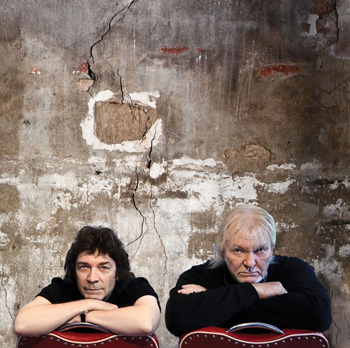
Squackett isn’t the first time you’ve collaborated with a member of Yes. Contrast the intent and outcome with GTR, the band you co-led with Steve Howe in the ‘80s.
GTR was a heavily-funded mid-‘80s band that was immediately corporately answerable for every note, every mix and every nuance that emerged from it. By comparison, even calling Squackett a cottage industry would be an overstatement. It was done in my living room. It was a small part of a building in which suddenly, your studio is the size of a computer screen. We were working in a domestic environment in which the computer was mightier than the building. There were no Hollywood studios involved with Squackett. My living room is not Metropolis, The Record Plant or Electric Ladyland. Most of Squackett was done on a shoestring budget, with the intention that at the end of it, there would be a finished record and that a record company would be found, eventually, that would like the whole thing so much that they would say “Yes, we will release this in its entirety.” The whole album was made honestly and crafted with energy and integrity, so that record buyers would be getting the real deal, as opposed to something that had been through the kind of osmosis that wheedles out lots of the good stuff. This is a much more full-bodied project.
Having said all of that, I think there was a lot to recommend about GTR at the time. I think both albums, taken at their best moments, can be very exciting indeed. Squackett seems to have immediately found favor. It’s an album that covered its advance in practically the first day, which is just as well, because I’ve been working to fund it since it started. It’s in the nature of the business to beg, borrow or steal these days. My wife Jo was also helping fund it from the word go. That’s the deal—it all comes back to the partnership. All I can say is the Squackett album is emotionally charged and real. It’s not a typically progressive record. It doesn’t have uncountable time signatures. It’s not meant to be impenetrable. It doesn’t crawl forward in an insect-like way in which you need a formula to figure out the direction it’s going in. It has very direct songs that speak to the head and the heart. Overall, there’s a sense of romance about it. Sometimes that’s about a direct romance between two people through love songs, but there’s also a romance of place in songs like “Tall Ships” and “Storm Chaser.”
Describe your living room studio and how it influenced the sound of the album.
When you’re recording at home, there are constant interruptions. People are constantly wandering in and out. Children walk in, babies are born, people are making toast. Whatever you’re doing, it’s not happening in a monastery-like way. In a typical studio, you’re in a place without windows. You’re functioning in a timeless void on rainy days. That’s very good, perfect recording weather. But if it was sunny, I could see it through the windows at home. The vast bulk of the album was done at home, with about half the bass and all of the drums done in another studio. The rest of the album involved months and months of chipping away at home over packets of crisps and bottles of wine. So, that does inform the thing differently. It’s a more relaxed way of working, and as a result, it probably resulted in a more relaxed album.
I suspect the Squackett album is closer in spirit to some of the ‘60s pop I listened to so much. I think it’s a very interesting album. It’s unlike anything I’ve ever done. I was worried at first, because I thought perhaps people might feel it didn’t have enough energy, but there’s something very comfortable about it. Also, obviously, Squackett hasn’t got a serious title. It’s sort of like Dire Straits. People are likely to dismiss it on those grounds. Its almost like saying you’re not very good. It’s like naming the project Daffy Duck. But, that’s the whole thing. It’s more “You should check it out, because actually, it’s…” This is about a “conquering by stealth” approach.
Squackett is related to the cozy magic of some of The Beatles’ works. It’s like a comfortable pair of sneakers. The Beatles were singing about comfortable things, as opposed to things that were designed to shake and change the world. Sometimes there was a bit of a tweak at the nose of the establishment, but you’ve got the sense of society jostling along with them in the grooves, rather than “Here we are, setting ourselves up completely separately.” From the age of 12, I was buying Beatles records. Now, I often wonder “What is it about The Beatles that made them rise above the rest? What did they have that other bands didn’t have?” Certainly, there was luck, but there was always this drive to succeed. I think they must have been very driven to work all night, every night. I think in those days, people tended to think everything was a flash in the pan, that it was going to happen for a couple of years. You had two years to make it, and then the public was going to forget you, so they would create two albums a year and pluck singles from it.
You asked me about my trajectory at the start of this conversation and the idea that I’m stepping into a higher gear. Squackett is part of that. I’m very proud of it. Originally, some of this material was intended for solo stuff, but then Chris started working on the pieces. He started saying “It would be nice if we could have that one for this project.” I thought “Well, if I do that, I’ll start losing control of it, but maybe I need to lose control of it.” I’ve had autonomy for a long time and it’s nice to have a musical partnership with Chris, as well as Roger King. Roger is a very important part of Squackett, with his arrangements and writing contributions, and through helming recording sessions.
Elaborate on King’s role on the album and in your career in general.
Roger is a very earthy character. He’s happy to discuss physics. He reads music. He engineers. He writes. He programs. He’s done film music. In order to get the Squackett album done, I wanted him to have a vested interest in it. So, I suggested to Chris that Roger could be the engineer. Roger is phenomenally talented. He’s also one of the few people who I allow to insult me. It’s taken as a term of endearment. We’re able to do that with each other and be very honest. He will tell me if he thinks something isn’t working. He has a dry sense of humor and he’s not afraid to rattle anyone’s cage, that’s for sure. That degree of honesty is very helpful when you’re making a record. The most I’ve ever heard Roger say when he gets enthusiastic is “I don’t mind that.” [laughs] It’s completely un-American as an approach. It’s completely about English understatement and that ironic sense of humor. I value it very highly.
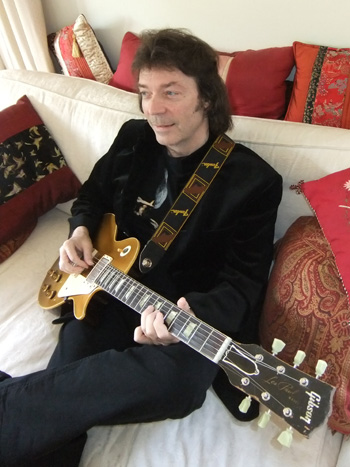
Tell me about your signal path for the Squackett album.
The main guitar is a custom Japanese Fernandes sustainer guitar that’s Les Paul-shaped, with a gold top. There’s also my nylon Yairi from 1983. I also have a 12-string guitar courtesy of the late, great Tony Zemaitis, who built wonderful instruments for Bob Dylan, George Harrison, and many more. There’s also a sitar guitar on the album, a copy of a Danelectro called a Baby Sitar. In addition, I have a custom steel-string Yairi from 1996. Sometimes, I combined it with the sitar guitar to create an interesting sound, which I used on “Can’t Stop the Rain.” It’s a laid back kind of track, slightly somewhere between Burt Bacharach and Steely Dan. It’s a bit jazzy, with lots of clean guitars—more than I usually have. Chris pushed me to do that. I wasn’t trying to do anything too heroic on that track. I just wanted to noodle around. There was no point in doing a screaming guitar solo on it. Being a guitar hero has its limits, doesn’t it? [laughs]
For pedals, I use Dunlop and Vox wahs, a Pete Cornish treble booster, Digitech Whammy, Line 6 DL4 delay, and a Sansamp GT2 to distort. In terms of amps, I used Marshall 1957 heads and Marshall 1960A cabs, as well as a variety of Apple Logic amp simulators.
What can you tell me about your approach to using amp simulators?
I’d have my head down or head back playing and not focusing on the screen. My focus is thinking “How am I going to make this sound? What can I do to make it sound like it’s going through an amp and moving a lot of air?” Amp simulators let me get the sounds on stuff like “Storm Chaser,” in which you would swear there is an amp blasting away in a corner, but there isn’t. These days, I don’t feel the need to work with the real thing in the studio. I like to use Marshalls live, but these amp simulators allow you to switch immediately between cabinets and mix and match different heads. Sometimes, I can get a very buzzy kind of distortion and other times I want something that’s really roomy and different. It all depends on the track and how densely packed it is. I never have a formula for it.
Some guitarists have had violent reactions to the amp simulation universe. What do you make of the purist perspective that they are no match for the real thing?
I have no issues with this stuff. I find the criticism surprising. Who are we hurting here? We’re not putting amplifier companies out of business. There’s always going to be room for that. I find it quicker on a typical day in the studio to work with amp simulators. If you have a studio that’s large enough, then you might have a Marshall that’s being overdriven, and have another Marshall overdriving that. Then your engineer goes in and sets up a mic on it, but you can’t play yet, because if you did, you’d deafen him, unless he’s wearing hearing protection. So, he comes into the control room and finds the sound a little too toppy. Next, he’ll go back out there and change it. And then, maybe the mic’s a bit too close to the speaker, or not close enough, so out he goes again. And this business will go back and forth for an hour or two. When it’s all in the box, it’s very different. One day, Roger King said to me “I changed the sound. I moved the mic.” We both laughed at this, as he meant he moved the mic virtually, in the computer housing Logic. So, I’m completely sold on this myself. I love the fact that we can do this.
I mentioned Joe Bonamassa earlier. In his sleeve notes, he’ll tell you what amp he used and the vintage this and that on a track. He makes a great noise and I love his sound and respect it. On the other hand, I’m the kind of guy that wants to make my Les Paul sound like a Stratocaster and make my Fernandes sound like a Gibson. I’ll do whatever it takes to fiddle with stuff to make it happen. I use everything, including corrective surgery. If I think every nape deserves a facelift, I’ll make it happen.
I should mention the other thing guitarists love to fool themselves with is volume, resulting in a substandard product. I know it’s heresy for some to hear me saying this, but the fact is you don’t have to turn up loud to get a great sound. I’ve been trying to prove this for centuries. I think I’ve finally managed to convince myself and others that it’s in the imagination.
You’re a fan of the Tech 21 SansAmp GT2 Tube Amp Emulator. What do you like about it?
I enjoy the smoothness. I also like to mix it with other things, so it’s part of the story, but not necessarily the whole thing. It has a number of presets that are very good. I actually use it for very little treble, to be honest. I prefer to use treble from the pickup on the guitar itself. I’m starting to use pickups more than I used to. You might say that playing with treble pickups can be very thin, but other times it can be absolutely wonderful. I did something in Germany recently, in which I played with an orchestra in a couple of places. They asked me to play “Blinded by the Light.” Having never played the song before in front of audiences, I chose to use bottleneck slide. So, the best bit of the whole show was something completely off the map—playing guitar on full treble with a burning kind of slide sound. It’s a weird thing. Sometimes you do this in a studio and it doesn’t quite work, but when it’s a spontaneous gesture you just go for in a live setting, it can be great. In the studio, too much treble can create a bit too much rattle, but live, the extra top can be absolutely great.
You’re evolving more and more towards a borderless sound. For instance, “Waking to Life” from Beyond the Shrouded Horizon is infused with Indian influences.
I’ve been experimenting with the idea of making the sitar guitar sound like an actual sitar since I began working on an album called Wild Orchids. That album has a track called “Waters of the Wild” in which we doubled the sitar guitar with keyboard-based sitar samples, as well as samples of sympathetic strings. For “Waking to Life,” I doubled what I did then. We sent the guitar signal through a virtual soundboard of a piano to create the sound of the sitar’s gourd. Sometimes, we reversed those sounds. We would play the whole lot backwards and it sounded very psychedelic. I admit I have a fascination with Indian music. It’s partly nostalgia of the ‘60s, but it’s also something interesting that rhythmically informs the straight-ahead snare on the 2 and the 4 of rock music. There seems to be more space in Indian music. I find it exotic. I love the way Indian singers use different kinds of vibrato above and below the note, and the relevant use of quarter tones. I think the guitar is potentially another voice that can use that influence.
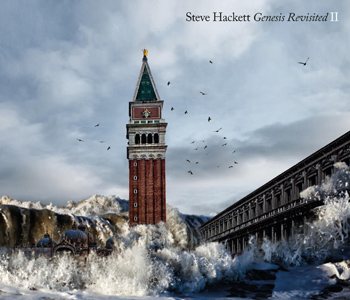
What made you want to further explore your ‘70s history via Genesis Revisited II?
For all sorts of reasons. I wanted to reclaim that music. The reason could be as simple as wanting to change the tone on something or explore a different kind of fuzzbox or stompbox. There are all sorts of reasons that music has been much applauded, but there are things that were recorded very quickly. At times, it was absolutely brilliant and other times it would have been nice to have had more time to do certain things. I’ve had 40 years to consider it with some of the material. I thought of some of the moments that were symphonic and wanted to take them a little further. It’s all in the details, really. There’s so much I wanted to do with the music at the time it was initially recorded with the band, some of which I achieved, and some I felt I still had to do. Some things that sounded good in rehearsal didn’t always sound great when they were first recorded. Also, I had a general sense of wanting to re-record my earlier material so I could be part of it again, and also tour it, which was a very big factor.
For many years, I didn’t touch this material. I thought I was trying to establish a whole separate idea and dream. Gradually, over time, I started to play more of these numbers as part of my show and I thought it was absolutely valid. I don’t have a problem if I hear a Beatle playing a Beatles tune, even though there hasn’t been a Beatles for a very long time. I think the template for this stuff was laid down by others way before me. Plus, there are 50-odd Genesis tribute bands doing the rounds, playing this material. I’m also always asked about vintage gear and attitudes, because people are absolutely fascinated by that period. My answer to them is I don’t think you have to use the exact gear in the same way to get the same effect. Perhaps you can even do better. The goal was to remake the same pot, but this time, perhaps without the cracks.
There isn’t a functioning group called Genesis at the moment. So, you’ll be the only person involved in the original material performing this music in any context.
That’s right, yeah. There’s also the aspect of the band dismissing that early work in favor of an era that followed, which had great commercial success. The earlier work is less slick, but it excels in terms of ideas, emotions, energy, and honesty. I think that’s where the true stuff lies for me. I think the era of Genesis I was part of was halfway between the sensibility of a jazz band and a pop group. We were in the middle somewhere. I won’t argue that the production on Genesis music got slicker, but ironically, I was one of the first people to get Phil Collins to work to a click track on my first solo album. Of course, the idea of working to a click track became the industry standard. Sometimes, you can be a frontrunner with these things and they’re not popular in their day, yet they become the norm later.
You’ve taken on the ultimate sacred cow by rerecording Genesis’ signature epic track “Supper’s Ready.”
I’m committing sacrilege with the sacred cow, because every note has been cast in stone, hasn’t it? [laughs] There are certain things I wanted to change and I’ve done that. There are more extensive guitar parts, as you might imagine, to embellish something that was already a very dense picture. I explored vintage fuzzbox sounds, together with Ben Fenner who engineered some of the material, but instead of using an actual fuzzbox and plugging it in, I used three fuzzboxes that existed in the virtual domain, all cranked up and working at once. It gave a real fizz to the fuzz. I also used lots of reverbs and repeats from Ben’s kit.
Phil Collins’ son Simon Collins is one of several vocalists on the new “Supper’s Ready.” Why did you choose a multi-vocal approach for it?
It’s an interesting idea. The keyboardist Dave Kerzner and Simon are both on the track. Dave is playing the keyboards on the “Apocalypse in 9/8” section. He’s been an impresario with this project. He was recording Simon’s contributions too. I played on an album of Simon’s a while back and he returned the favor for me on this album. So, it has come full circle in a number of ways, hasn’t it? I sing on “Willow Farm,” and Mikael Åkerfeldt, Francis Dunnery, and Conrad Keely also appear on it. I think they all have something different to offer. Some people have the voice of experience. Some are younger singers with a certain kind of freshness that gives it almost a garage band feel at times. The pieces go through a number of different moods. “Willow Farm” is where everything is changing and the voices go high to low. I tried lots of different feels on that. It required me to be about 20 different singers. With the aid of technology and different approaches, there was a lot I could do as an actor. In a way, each line begged to have a different character. So, I’ve taken that to its logical conclusion throughout the song and it seemed to benefit from that approach enormously.
There’s so much to this new version. Even reviewing it from beginning to end is a significant endeavor. I needed to have a spare half-hour just to listen back to it. There was an endless shopping list with this thing. The Olympics took place in London this year, but I felt I was engaged in my own Olympics working on this track, and the album in general. The album went down to the wire in terms of its due date in August. I had two teams working on it. It was rather like doing a film, where you have a second camera unit that might be picking up atmospheres and details. So, at one point, one drummer was being recorded by Roger King and another drummer was being recorded by Ben Fenner at the same time. I was busy working on guitar parts, vocal stuff, and working out how I can make certain changes, links and atmospherics in order to make the thing whole. I wanted it to feel like a musical continuum and give “Supper’s Ready” a feeling of an endless journey. Roger was working on mixes and editing, while I was working on the guitar detail and vocal stuff.
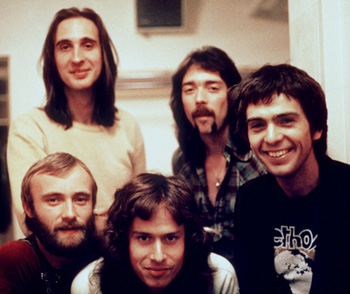
The album also includes a section called “Genesis branches.” Tell me about some of the pieces and why they complement the Genesis material.
They’re tracks that I rehearsed with Genesis and in some cases were recorded by some of the Genesis guys on my solo albums. They’re all of the same period. For instance, “Tower Struck Down,” was an early solo piece Mike Rutherford and Phil Collins played on, originally. My brother John Hackett wrote part of it. I wanted to play the guitar riff on the new version as he played it to me many years ago, which he saw as a more Led Zeppelin-esque thing. I also redid “The Steppes” a la Stravinsky, with real strings stabbing away, before the group comes in. The album has meat everywhere. It’s a double CD, with each disc being about 73 minutes long. It’s not like it’s one CD and a CD of bonus tracks, or bogus tracks, as some people call them.
Tell me about the other players who appear on Genesis Revisited II.
We also have Steven Wilson, Jakko Jakszyk, Nads Sylvan, Nick Beggs, Steve Rothery, Roine Stolt, John Wetton, Nik Kershaw, John Hackett, Jeremy Stacey, Lee Pomeroy, Christine Townsend, and Rachel Ford. I also have Dick Driver on the album, who was in the band Quiet World, the group I was in before joining Genesis. My regular band including Amanda Lehmann, Roger King, and Gary O’Toole appear as well. It’s really an orchestra and a choir. Most of the people who took part have done so as a labor of love. They’ve said this is highly-influential material for them, so it has not been done as a business decision for them whatsoever. That hasn’t come into it at all. So, that’s been great. It does mean I owe a lot of favors, mind you, but it’s a nice position to be in.
Describe Steven Wilson’s contribution to the album.
Steven sings on “Can-Utility and the Coastliners.” He recommended I do that track because he likes it. I probably wouldn’t have approached it otherwise, as it’s something that was on the close of the first side of Foxtrot. It was easy to overlook in the shadow of “Supper’s Ready.” Steven was also mad keen on “Shadow of the Hierophant.” I started doing it live again because he suggested it, and it went down an absolute storm with audiences. I was worried it was too old-fashioned, but it was just what they wanted to hear. So, he plays guitar on that track at the end.
Steven is very keen on early sounds and classic gear, but at the same time, he’s the guy doing 5.1 mixes of everyone’s back catalog. He’s both high tech and retro. He’s passionate about what we now call progressive music, but we never called it that in its day. I think if we had known we were making progressive music, we would have stopped straightaway. [laughs] It has all been lumped into that category—everything from Pink Floyd to ELP. I can’t think of two bands that were less alike. There is a danger with progressive music in that it can end up becoming too much about punctuation and not enough statement.
To return to Steven, he has a handle on things these days. He’s passionate about progressive music and his solo stuff is very interesting and dynamic. He seems to view tonality very well. His music seems to be either very quiet or very raucous, and he’s definitely into the darker stuff. He also recommended Mikael Åkerfeldt to me, and that’s why he’s on the album.
Have you thought about having Wilson remix your back catalog into 5.1?
There is the possibility of doing 5.1 mixes of some of the early albums, but because I’m so involved with Genesis Revisited II, I think I’ll postpone that until later. It might be a Steven Wilson project, because I know he’s very keen on doing Please Don’t Touch, which is one of his favorites. He’s been very kind about that. He said it’s his Sgt. Pepper and that it’s even better than that. I’m not so sure about that, but I’m quoting him. [laughs] I own the rights to most of my back catalog, apart from the early albums that were signed to Charisma, then to Virgin, and then picked up by EMI—from Voyage of the Acolyte through to Highly Strung.
When you did Genesis Revisited I, you tried to get Tony Banks involved. What happened?
I did ask Tony at the time and he said he would participate. Then, for some reason, he said “I’ve been thinking about this and I’m not really comfortable about it.” There are many other people I could have asked to come back for Genesis Revisited II. I could have asked Paul Carrack, but we did bring back John Wetton again. He sings “Afterglow” beautifully.
In terms of guitar work and soloing, what will listeners notice has changed on Genesis Revisited II?
I’d like to think everything is more under control. It’s certainly more in time and tune than my earlier efforts. I tried to change certain parts, and I’ve also included occasional nylon guitar introductions to things. For instance, there’s a nylon intro to “Blood on the Rooftops” from Wind and Wuthering. I’ve done that, but extended the intro to include many other things. It’s more of a nylon guitar workout than anything else. I built an extension to the house, really. Having said that, I re-recorded “Horizons” on my steel-string Yairi. I was after a similar sound, but with a little more panache and control. The original guitar on Foxtrot was a Yamaha rhythm guitar. Normally, I use a nylon Yairi, but occasionally, I use the steel one.
What other guitars are you using on the album?
I also used my Tony Zemaitis 12-string extensively on the album, because there is a lot of 12-string work in Genesis. Sometimes there were four 12-strings all chiming away at once. I also use my gold-top Japanese Fernandes sustainer guitar. The nylon guitar is a Yairi instrument that I bought in 1974. It’s a little more difficult to play than some others, but it’s as loud as a piano. It can be a little uncomfortable for recording if you really lay into it. I’ve also used a Rickenbacker 6-string that is on permanent loan from my cousin.
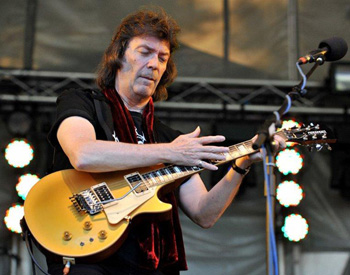
What did you use to replicate or transform the original Genesis guitar tones for the album?
I’m using my ears as much as anything. We tended to switch amps and cabinets all the time in the virtual domain. Ben Fenner prefers to work with ProTools, so I’d be working with him while Roger King was rationalizing other tracks and starting to mix them. Roger prefers Logic, so these guys have different virtual things at their fingertips. I used the Sansamp GT2 for the majority of distortion, but I’m using the parameters of the amps within the box as well. As I mentioned, I’ve gone back to using vintage fuzzbox sounds so I can get that really toppy fuzzy thing happening that I first heard Jeff Beck use. It’s the culmination of reverb and very bright fuzz, which is the sound I’m often credited for. In actuality, there were a number of people doing that as well at the time, including Keith Richards.
The album opens up with a nylon string introduction to “The Chamber of 32 Doors.” Describe what’s going on in it.
It’s a hybrid of jazz, flamenco and classical influences that I play on my 1974 nylon-string Yairi. I’m interested in all of those things, including certain scrolls and right hand moves. I also find the “Concierto de Aranjuez” by Joaquín Rodrigo interesting, particularly the bit towards the end of the slow movement before the orchestra comes in, when it sounds like a thousand fountains are bubbling away. I’m in ecstasy whenever I hear that. When I first heard Julian Bream playing that part, I was completely blown away. It’s a technique I can do. I have a number of ways of employing that right-hand technique. You can do it by using nearly all of your fingers to arpeggiate upwards and then do a downward stroke from top to bottom, with a stiffly-held forefinger. Another way is to use sweep-picking technique so you can do it all with a firmly held plectrum. The way I prefer doing it, because I rarely use plectrums these days, is to use the nail of my forefinger, but held very stiffly and supported by the thumb very tightly. It translates quite well to the world of flamenco guitar.
Also, I play this piece on a new tuning that I developed. As far as I know, I’m the only one using it. On this tuning, the low E goes down to D, the low A goes down to G, and to cap it off, the B goes down a semitone to B-Flat. When you play chords with that shape, it sounds very melancholic, very Death in the Afternoon. It’s a very Spanish-sounding tuning. It’s a kind of G-minor, in a sense. It’s also great for lots of other chords that I don’t profess to know the name of. But they are truly wonderful chords.
You mentioned Quiet World earlier. How do you look back at your work on the band’s 1970 album The Road?
I was a hired gun for that one. I think much of it is of its time, but there are some moments on it that work very well. I’m surprised my timing on it was as good as it was. I think my timing actually got worse instead of better, afterwards. There were great, long takes which are really in time. Maybe I was just tired. [laughs] If I’m on the ball, I have a tendency to be ahead of the beat. Timing is a weird thing to get absolutely right. I don’t think anyone who arpeggiates can be absolutely in time to a click.
Is there a spiritual side to what you do?
I think there is. Spectral Mornings was certainly about the potential survival of personality. There were a lot of subjects that covered death, but it was optimistic. My money is on survival. In what shape or form, we don’t really know, but I have had some psychic experiences myself and they completely defy logic. I’ve also encountered some evidence of survival. Everyone’s got to go their own way. That may upset half of your readership at least, and the other half may be interested. I’m not religious. In other words, my take on religion is that it posits a hypothesis of certainty. That doesn’t mean I don’t believe in the survival of personality, though. So, there we are. I come out on that side. But I’m also happy to join the cynics on another level, including all the stuff about the Flying Spaghetti Monster. Google that one if you’re unfamiliar with it. It comes under the heading of people’s right to be able to worship any deity they see fit.
Roger King on the making of Squackett’s A Life Within a Day:
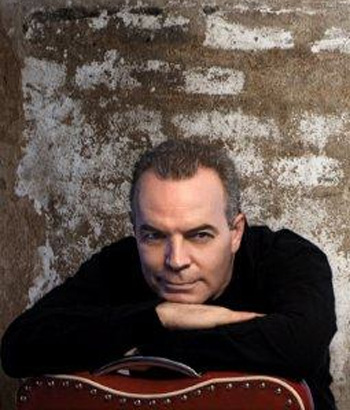
Describe your roles on the Squackett album.
In short, I accumulated all the data and stuck it together to form a coherent whole, but production, arrangement and engineering would be more traditional nomenclature. It would be dishonest for me to claim too much credit—Steve and Chris originated the majority of the material and putting the album together was very much a collaborative affair. But the mixing and mastering, at least, were essentially my responsibilities alone. Oh, and I tickled the odd ivory, too.
You co-wrote the entirety of the album. Describe how you factored into the album's creative process.
Every song was different. Steve and Chris both brought songs to the project that were close to structurally complete but some way short of the finished article. Some we wrote together in traditional "what word should come next?" fashion and some material grew out of the production process. There isn't any longer a clear distinction between songwriting on the one hand and production/arrangement on the other. I would describe the entire process as creative.
Tell me about how you function as a sounding board for ideas in progress with Steve.
More of a sponge than a board—a "sounding sponge." Term coined and copyrighted! It's a little like a cookery program where the celebrity chef is given a collection of miscellaneous ingredients and challenged to turn them into a three-star meal. Music production is 90 percent craft, I think. Give me the raw materials and I can use my production chops to fashion a consumable product. That's the theory, anyway.
You've figured out a way to record Steve's guitars with exquisite clarity and detail in his living room environment. What tools and processes are you using to enable this outcome?
The bulk of the recording’s clarity and detail comes from Steve's obsessive pursuit of guitar tone and performance, but we used plugins to recreate the effect of a set of speakers moving air in a real space. I record and mix in Apple Logic so Logic's own amp simulator is the first port of call. It's a bit of a mixed bag, but some models are really excellent. We favored a small tweed head and 1x12 cab for the Squackett album. I routinely added some short room reverb from Logic’s Space Designer convolution plugin to provide a bit of woody resonance. By and large it's very effective. We lose perhaps a few percent of character, insofar as it can be quantified, but gain the flexibility of adjusting the guitar tone right up to the final stages of the mix.
What challenges does recording in this environment create and how do you address them?
Noises off, mainly. We sound engineers have all spent years pursuing low-noise recording through acoustic treatment and ever-better electronics, so it takes a bit of attitude realignment to just go with the noisy flow. There is a squawking flock of yellow parrots that does the rounds in Twickenham and they undoubtedly make a subliminal appearance on the album somewhere, along with cars, children, door slams and so on. I guess it all adds character.
Tell me something about the making of Squackett no-one else knows.
Chris has the loudest singing voice ever. Goodness knows what the neighbors made of his vocal sessions. We didn't have any complaints that I'm aware of, so I can only assume that everyone ran for the hills.
Ben Fenner on Genesis Revisited II:
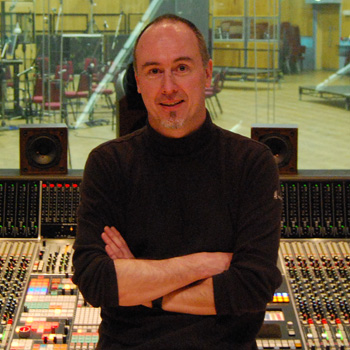
The recording chain for the guitars that I recorded with Steve on Genesis Revisited II was:
Steve's Guitar, a Gold Top Burny, went into a SansAmp and then into the volume pedal. The output of the volume pedal went straight into the Hi-Z input of a Summit TPA-200 tube preamp and this was followed by a Summit EQP-200 tube EQ which was then patched straight into my Digidesign ProTools interface.
I used ProTools 10 to record and post-process everything, and all guitar processing was done inside of ProTools as well, using IK Multimedia AmpliTube 3 for everything apart from some delays and reverbs.
The sound for “Supper's Ready” arose from a discussion with Steve about the old days in Genesis where he said he used to use two fuzzboxes to get the extra sustain and emphasis on the upper harmonics he was after. I found a preset on AmpliTube 3 that used, among other things, two Fender Blender Fuzz/Wahs going into a '59 Fender Bassman.
This proved a great starting point, and once I got rid of the other pedals in the chain and tweaked the settings, it was sounding pretty good but needed something extra to capture the sound that Steve was hearing in his head. This proved to be the addition of an XS Fuzz, modeled on the Roger Mayer Axis Fuzz, inserted after the second Fender Blender. In my opinion, this took the sound to a slightly more mental level of gain than we were after originally, but it certainly did the trick, and Steve being the complete and consummate master of controlling huge amounts of gain that he is, played it superbly.
For my part, I prefer the Summit preamp and EQ in the record path for two reasons. I know that the Summit preamp sounds better than the mic preamp in my audio interface, and having the two nice analog units in the path with their big knobs means I can easily tweak levels or EQ of what is going into the amp simulator. Incidentally, this is also the signal chain when recording vocals, with the addition of a compressor at the end of the chain, just before the interface line in.
Dave Kerzner on Genesis Revisited II:
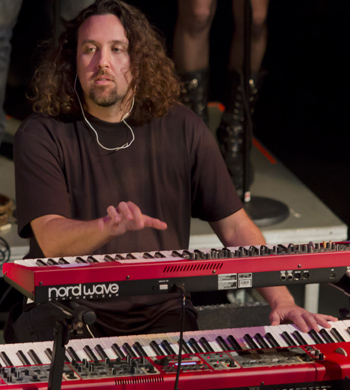
How did you get involved in Genesis Revisited II?
Steve Hackett played on an album that I also played on called U-Catastrophe by Simon Collins, who is Phil Collins' son. I've been in touch with Steve since then about both himself and Roger King, using Sonic Reality and IK Multimedia products that I've had a hand in making. When I heard he was doing Genesis Revisited II, I offered to play keyboards and help record singers like Simon Collins and Francis Dunnery. So, we got to be part of the songs "Dancing with the Moonlit Knight" and "Supper's Ready."
Describe your contributions to "Supper's Ready."
I was given a few sections of the song to work on and flew up to Canada where Simon lives to record him in the studio. We worked on "The Guaranteed Eternal Sanctuary Man," "Apocalypse in 9/8" and "As Sure As Eggs Is Eggs," which is the epic end section after "Willow Farm." Besides recording Simon and Francis' vocals for it, I also contributed my own keyboard performances, sharing the spotlight with Roger King for the big organ solo and triumphant lush finale. We both used a product I made with IK Multimedia called "SampleTron" as well as other vintage sounds to recreate the authentic flavor of the song.
What are your thoughts about how the track turned out?
I couldn't wait to hear the final version. All of our overdubs were done to temporary stems. So, to hear it all together with the real tracks as well as the other sections with different singers really was a trip. It's such a powerful, emotional song. There was an unexpected surprise guitar solo from Steve that came in during the organ solo shared by Roger King and myself. That made it more like a jam between the three of us and that was cool. To me, there are a few different approaches you can take covering a song this long with so many parts. You can either do it with one singer, guitarist, keyboardist etcetera, like the original, but embellish the arrangement, or you can do what Steve did which is make it an epic celebration with a variety of guests giving their best to it. Since that seems to be the spirit of the whole album, it makes sense for him to go that route with this song which is like a mini-album within an album.
What does it mean for you to be a part of this project?
It was a dream come true. Being a keyboard player who grew up listening to Genesis, this was a very rare opportunity to play on an iconic early Genesis song with one of the guys who wrote and played it originally. I've had a few rare "fantasy Genesis" moments in my life. One of them was performing The Lamb Lies Down on Broadway with Kevin Gilbert and Nick D'Virgilio in 1994. Another was doing a cover of "Keep It Dark" with Simon Collins which was played before the last Genesis concert in 2007. But to also be part of Genesis Revisited II just makes the 14-year-old inside me proud. Besides that, I really love to work with great musicians on music that inspires me. Steve is incredibly down to earth and treats the musicians he works with respectfully and with no ego. You're comfortably on the level with him and we all felt appreciated for what we did. That means a lot to me.
Photo Credits:
Live Steve Hackett photos by Lee Millward
Dave Kerzner photo by Erik Nielsen